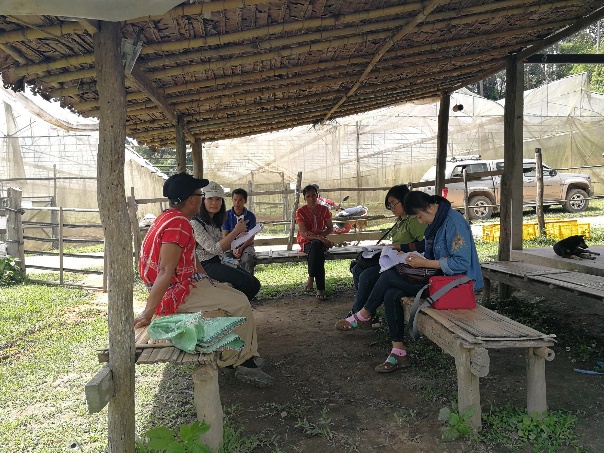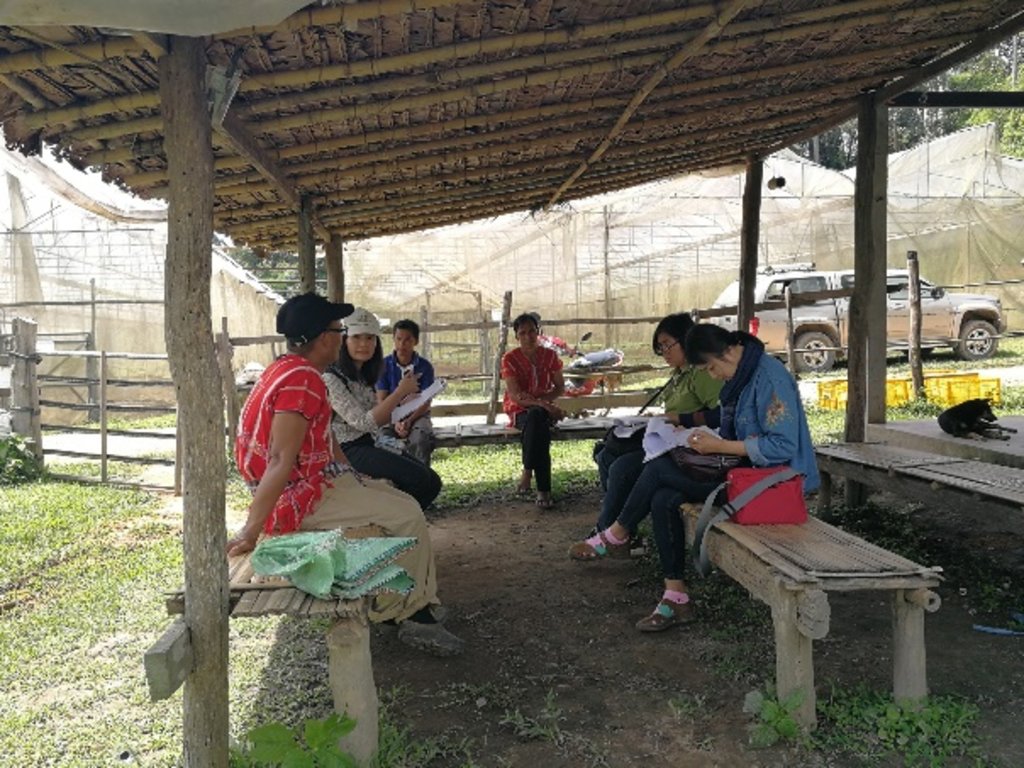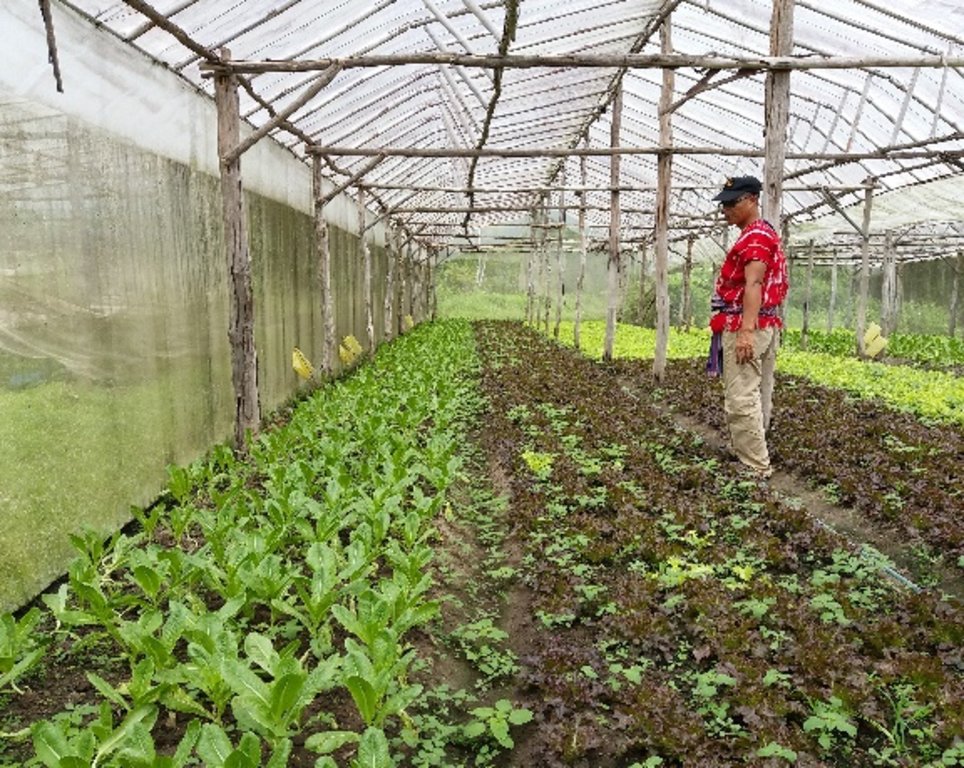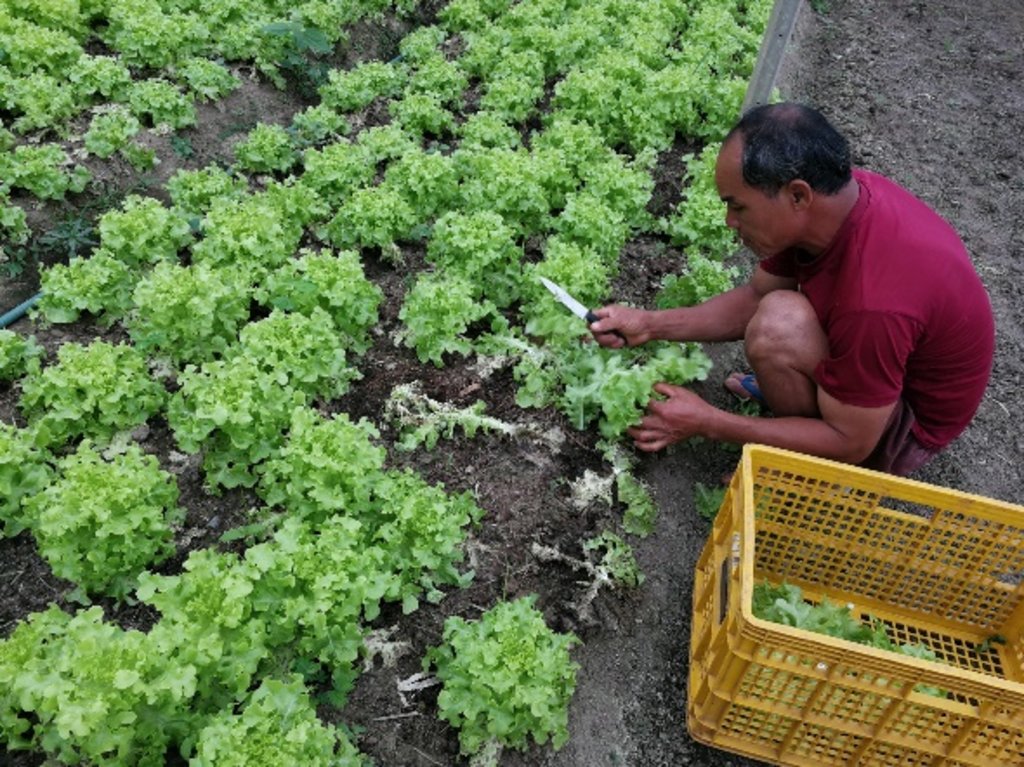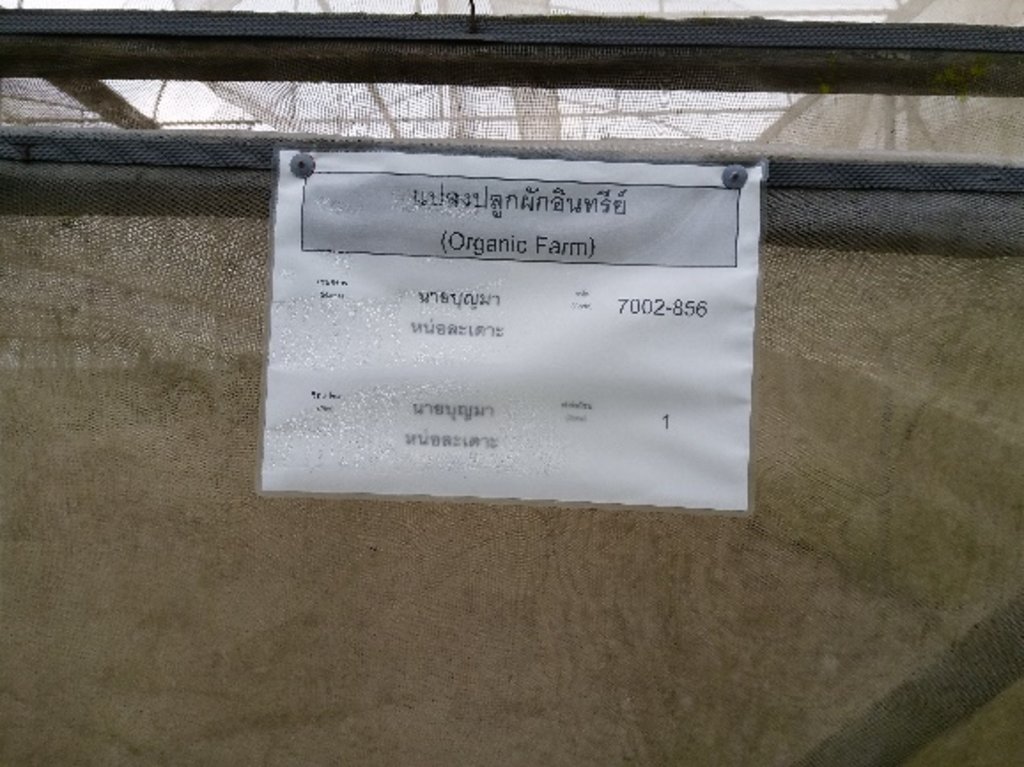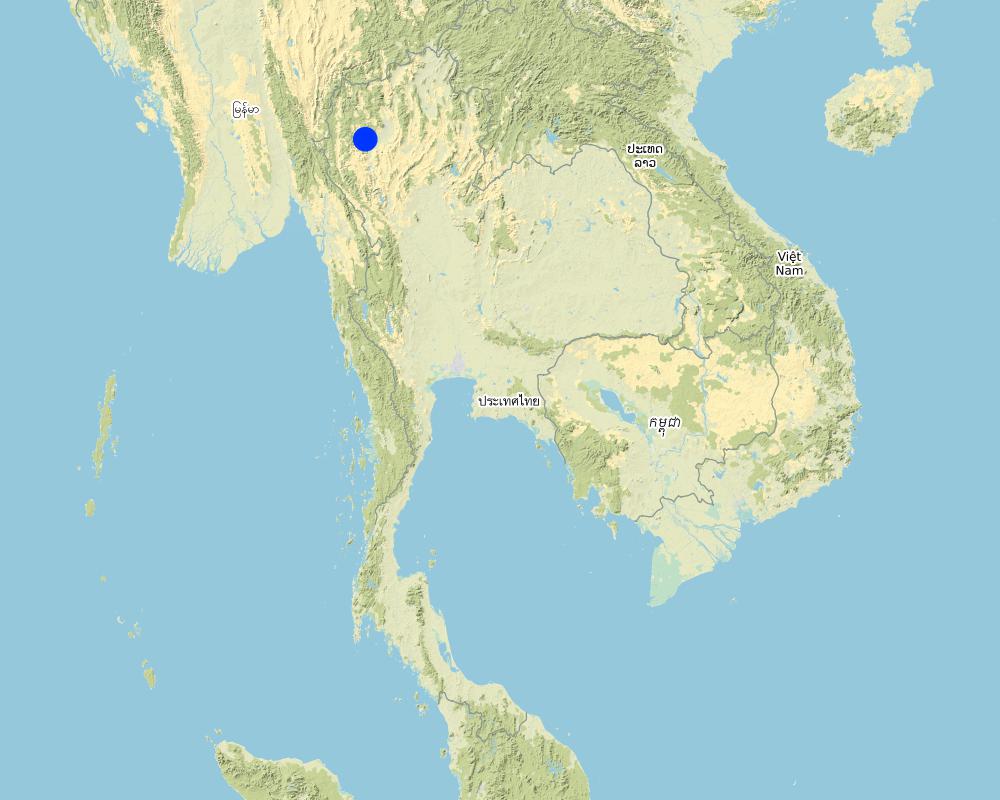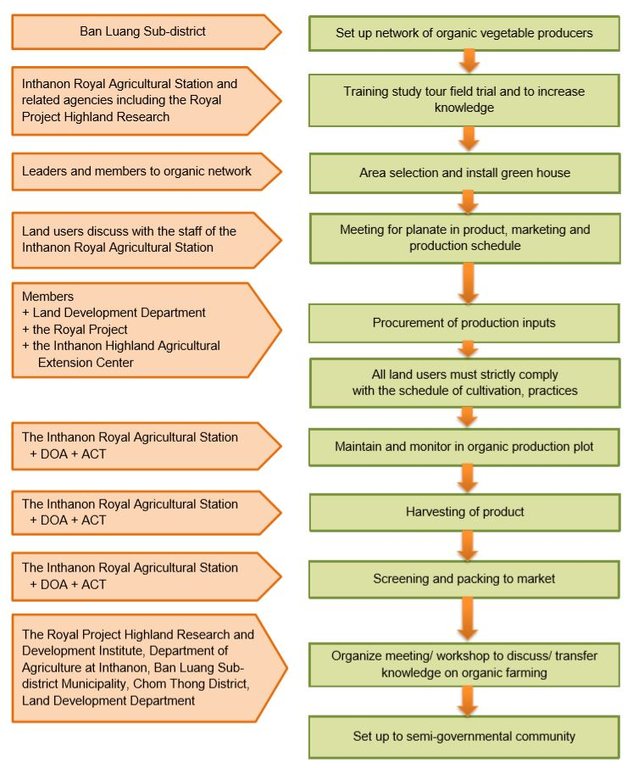Changing the Crisis of Degraded Land to Opportunities: Organic Vegetables under the Royal Project [Thailand]
- Creation:
- Update:
- Compiler: Pitayakon Limtong
- Editor: –
- Reviewers: Rima Mekdaschi Studer, William Critchley
Organic vegetables in the Royal Project
approaches_4308 - Thailand
View sections
Expand all Collapse all1. General information
1.2 Contact details of resource persons and institutions involved in the assessment and documentation of the Approach
Key resource person(s)
co-compiler:
Wattanaprapat Kamalapa
1760 Ext. 5114 / 0836553915
kamalapa_w@hotmail.com
Land Development Department,
2003/61 Paholyothin Rd., chatuchak, Bangkok 10900
Thailand
land user:
Ponganabandit Watcharin
085-7238510
-
98 mu 9, Ban Luang
Thailand
local officer:
Siriphuvadun Boonsri
081-1639230
Inthanon Royal Agricultural Station
175 Mu 1, Wanghamhae Sub-district
Thailand
1.3 Conditions regarding the use of data documented through WOCAT
When were the data compiled (in the field)?
13/09/2018
The compiler and key resource person(s) accept the conditions regarding the use of data documented through WOCAT:
Yes
2. Description of the SLM Approach
2.1 Short description of the Approach
This organic vegetable cultivation is the result of the integration of many government and private agencies to assist in training and transferring knowledge and experience to all members of the community network. The land users change the crisis of degraded land to opportunities through producing organic vegetables in the Royal Project.
2.2 Detailed description of the Approach
Detailed description of the Approach:
The organic vegetable cultivation at Doi Inthanon National Park is located in Muang Ang Village, Ban Luang Sub-district, Chom Thong District, Chiang Mai Province, where the topography is steep and mountainous. In the past, the Pakakeryo hilltribe used the land for shifting cultivation, which made the forest area continuously diminish. Almost all land users and their leaders in the village need to solve this problem by modifying their production system to increase their income by changing the production to the more eco-friendly practice in the form of organic agriculture farming. The main principles are: (1) develop the integrated and self-reliant agricultural production system in terms of organic farming, (2) maintain abundance of natural resources, (3) maintain the balance of ecological systems and sustainability on farms, and (4) prevent and avoid practices that cause pollution to the environment, including giving support to the natural post-harvest and processing practices, energy saving and the least impact on the environment.
Operating procedures:
1. Establishment of networks: All land users set up networks of organic vegetable producers.
2. Integrated cooperation: Government agencies organize training on organic farming at least once a year.
3. Selection of the area: Leaders and members select the area for members.
4. Production planning: land users discuss with the local officer in production schedule.
5. Procurement of production inputs: All materials to be used must be organic and are from reliable sources.
6. Organic vegetables cultivation: All land users must strictly practice soil improvement, control of pests and diseases.
7. Production monitoring: Local officers monitor and observe land users’ practices in production process.
8. Harvesting of Products: All land users must harvest and preserve products as certification method.
9. Screening and packing: All land users must clean and screen the quality of products and pack for delivery.
10. Community network: This network and related agencies organize meeting/workshop to discuss/transfer knowledge.
2.3 Photos of the Approach
2.4 Videos of the Approach
Comments, short description:
-
Location:
-
Name of videographer:
-
2.5 Country/ region/ locations where the Approach has been applied
Country:
Thailand
Region/ State/ Province:
Ban Luang Sub-district, Chom Thong District, Chiang Mai Province
Further specification of location:
Organic vegetables plot with greenhouse at Doi Intanon is located in Ang village, Ban Luang sub-district, Chom Thong District, Chiang Mai Province
Comments:
The area is located in upstream of the watershed where there is no pollution. All land users in this area would produce green organic vegetables for the market. They have been certified in organic standards by Department of Agriculture (DOA), Organic Agriculture certification Thailand (ACT) and Agri-Food & Veterinary Authority of Singapore (AVA).
Map
×2.6 Dates of initiation and termination of the Approach
Indicate year of initiation:
2002
If precise year is not known, indicate approximate date when the Approach was initiated:
10-50 years ago
Comments:
Almost land users know and understand the importance in preserve the environment, ecosystem and increase in their income, which is to strengthen food security and safety.
2.7 Type of Approach
- project/ programme based
2.8 Main aims/ objectives of the Approach
The approach is to ensure that the the main guidelines of organic vegetables cultivation to national and international standards are followed and land users are fully aware of how they must cultivate the land and maintain the ecosystem balance.
2.9 Conditions enabling or hindering implementation of the Technology/ Technologies applied under the Approach
availability/ access to financial resources and services
- enabling
The Royal Project supports good quality vegetable seeds for all land users and deduce the seed cost after farmers have sold their products.
institutional setting
- enabling
Establishment of organic vegetables group, water users group and compost-organic fertilizers group.
collaboration/ coordination of actors
- enabling
Create a strong community network in assisting each other to work in organic vegetables production.
legal framework (land tenure, land and water use rights)
- hindering
All land users do not have right in land ownership.
policies
- enabling
In accordance with the government policy in Thai Kitchen To The World Kitchens program, and organic agriculture.
knowledge about SLM, access to technical support
- enabling
The integration of several government and private agencies to promote this SLM in training, transferring, monitoring and inspecting to all land users.
markets (to purchase inputs, sell products) and prices
- enabling
There are markets for standard organic products, where farmers can sell organic products continuously, with stability and high prices.
3. Participation and roles of stakeholders involved
3.1 Stakeholders involved in the Approach and their roles
- local land users/ local communities
Almost all land users are Pakhayo hilltribe.
They are land users and maintenance their organic production.
- community-based organizations
Inthanon Royal Agricultural Station and Department of Agricultural Extension
Promote career, provide advice, academic knowledge, support production factors and packaging
- local government
Ban Luang Sub-district Municipality, province organization and several agencies
Organize technology transfer in organic vegetables production to encourage and extend to other villages.
3.2 Involvement of local land users/ local communities in the different phases of the Approach
| Involvement of local land users/ local communities | Specify who was involved and describe activities | |
|---|---|---|
| initiation/ motivation | self-mobilization | All villagers in this area faced problems with land degradation, low yields and insufficient income. The Inthanon Royal Agricultural Station promotes organic vegetable production, to eventually raise the quality of life of farmers. |
| planning | interactive | In 2011, a number of land users joined a study trip to attend a training course in vegetables production under greenhouses at the Mae Tho Royal Project Development Center. |
| implementation | interactive | All land users established a network of organic vegetable producers group and water users group. |
| monitoring/ evaluation | interactive | IFOAM organic standards are used to examine products; they have regulations for punishment of network members who fail to follow the instructions. They are also monitored by several government agencies. |
| ถ่ายทอดเทคโนโลยีการผลิตพืชอินทรีย์ | none | สถานีเกษตรหลวงอินทนนท์ ร่วมกับสถาบันวิจัยและพัฒนาพื้นที่สูง (องค์การมหาชน) , ศูนย์ส่งเสริมการเกษตรที่สูงอินทนนท์ , เทศบาลตำบลบ้านหลวง , อำเภอจอมทองและหน่วยงานที่เกี่ยวข้องในพื้นที่ร่วมจัดงานถ่ายทอดเทคโนโลยีการผลิตพืชอินทรีย์เพื่อขยายกิจกรรมไปสู่หย่อมบ้านอื่นๆ ปัจจุบันปี 2560 บ้านเมืองอางผลิตพืชอินทรีย์ที่มีคุณภาพได้รับการรับรองมาตรฐานจาก 3 หน่วยงาน คือ กรมวิชาการเกษตร สำนักงานมาตรฐานเกษตรอินทรีย์ประเทศไทย (มกท.) และหน่วยงานรับรองมาตรฐานเกษตรของประเทศสิงคโปร์ |
3.3 Flow chart (if available)
Description:
Operating procedures
1. Establishment of networks: All land users set up networks of organic vegetable producers and register the members properly; all members must act strictly according to the regulations.
2. Integrated cooperation: The Inthanon Royal Agricultural Station and the Inthanon Highland Agricultural Extension Center(ศูนย์ส่งเสริมการเกษตรที่สูงอินทนนท์) organize training on organic farming at least once a year, including study trip/s to visit other successful organic farmers.
3. Selection of the area: Leaders and members select the area for members, each member occupying not more than three greenhouses, 6m wide, 30m long and 3-5m high (180 sq m).
4. Production planning: land users discuss with the staff of the Inthanon Royal Agricultural Station, and plan the production of organic vegetables according to the schedule and types of vegetables to meet the market demand, as well as set up penalties in case certain members fail to follow the plan.
5. Procurement of production inputs: Both of local officers with inspectors and farmers can buy production inputs by themselves. All materials must be organic and are from reliable sources. Farmers must be very careful in this matter, i.e. they have the right specification from the agencies when they purchase.
6. Organic vegetables cultivation: All land users must strictly comply with the schedule of cultivation, practices in soil improvement, control of pests and diseases, plus recording every step of their activities.
7. Production monitoring: Staff of the Inthanon Royal Agricultural Station and Department of Agricultural Extension (DOAE) monitor and observe land users’ practices in using soil improvement methods and using bioproducts for controlling insects, predators, parasites and diseases. Department of Agriculture (DOA) and the Organic Agriculture Certification Thailand (ACT Organic) monitor the production process in organic farming.
8. Harvesting of Products: All land users must harvest according to the harvesting schedule and the preservation methods for the products. DOA and ACT Organic serve as certification agencies by analyzing the contamination of substances in the products.
9. Screening and packing: All land users must clean their products with non-contaminated equipment, and also screen the quality and specified size/s of products to pack in baskets for delivery to the Inthanon Royal Agricultural Station.
10. Community network: All members of this network and related agencies including the Royal Project Highland Research and Development Institute, Department of Agriculture, at Inthanon, Ban Luang Sub-district Municipality, Chom Thong District, Land Development Department and others organize meeting/ workshop to discuss/transfer knowledge on organic farming as needed.
Author:
Ms.Kamalapa Wattanaprapat
3.4 Decision-making on the selection of SLM Technology/ Technologies
Specify who decided on the selection of the Technology/ Technologies to be implemented:
- all relevant actors, as part of a participatory approach
Explain:
-
Specify on what basis decisions were made:
- evaluation of well-documented SLM knowledge (evidence-based decision-making)
4. Technical support, capacity building, and knowledge management
4.1 Capacity building/ training
Was training provided to land users/ other stakeholders?
Yes
Specify who was trained:
- land users
- interested people
If relevant, specify gender, age, status, ethnicity, etc.
-
Form of training:
- farmer-to-farmer
- demonstration areas
- public meetings
- courses
Form of training:
- made in VDO and broadcast
Subjects covered:
Cultivation of organic vegetables at Muang Ang Village
Comments:
-
4.2 Advisory service
Do land users have access to an advisory service?
Yes
Specify whether advisory service is provided:
- on land users' fields
- at permanent centres
Describe/ comments:
Several local officers from Inthanon Royal Agricultural Station, Department of Agriculture and Organic Agriculture Certification Thailand and others.
4.3 Institution strengthening (organizational development)
Have institutions been established or strengthened through the Approach?
- yes, greatly
Specify the level(s) at which institutions have been strengthened or established:
- local
Describe institution, roles and responsibilities, members, etc.
Establishment of the community enterprise in organic vegetables is to strengthen in earning sustained and high income, and also to improve farmers’ knowledge and experience. Moreover, several local officers organize training courses and study trips for members of this network.
Specify type of support:
- financial
- capacity building/ training
- equipment
Give further details:
-
4.4 Monitoring and evaluation
Is monitoring and evaluation part of the Approach?
Yes
Comments:
The activities of monitoring and evaluation are organized by the Inthanon Royal Agricultural Station, the Department of Agriculture and the Organic Agriculture Certification Thailand.
If yes, is this documentation intended to be used for monitoring and evaluation?
Yes
Comments:
-
4.5 Research
Was research part of the Approach?
Yes
Specify topics:
- economics / marketing
- ecology
- technology
Give further details and indicate who did the research:
Highland Research and Development Institute (Public Organization)
5. Financing and external material support
5.1 Annual budget for the SLM component of the Approach
If precise annual budget is not known, indicate range:
- 2,000-10,000
Comments (e.g. main sources of funding/ major donors):
The main budget is supported by the Royal Project Foundation, the Department of Agriculture Extension, Sub-district Municipality Organization and others.
5.2 Financial/ material support provided to land users
Did land users receive financial/ material support for implementing the Technology/ Technologies?
Yes
If yes, specify type(s) of support, conditions, and provider(s):
All land users receive inputs such as dolomite, compost, microbial activators LDD1 and LDD2, and funds to build check dams, farm roads, etc.
5.3 Subsidies for specific inputs (including labour)
- agricultural
| Specify which inputs were subsidised | To which extent | Specify subsidies |
|---|---|---|
| production materials | partly financed | Dolomite, microbial activator for compost and bio-extracted solution. |
- infrastructure
| Specify which inputs were subsidised | To which extent | Specify subsidies |
|---|---|---|
| road and check dam | partly financed | Farm road and check dam |
Comments:
-
5.4 Credit
Was credit provided under the Approach for SLM activities?
Yes
Specify conditions (interest rate, payback, etc.):
Free of interest
Specify credit providers:
Royal Project Agricultural Cooperatives and organic vegetables producers group support some production materials.
Specify credit receivers:
Land user members of this network.
5.5 Other incentives or instruments
Were other incentives or instruments used to promote implementation of SLM Technologies?
Yes
If yes, specify:
All land users know and understand the benefits of ecological system services, preservation of forest in upstream watershed, production of safe food for consumers, and increasing their income throughout the year.
6. Impact analysis and concluding statements
6.1 Impacts of the Approach
Did the Approach help land users to implement and maintain SLM Technologies?
- No
- Yes, little
- Yes, moderately
- Yes, greatly
Almost all land users have joined in the established organic vegetable production group, the main purpose of which is to support knowledge and production materials.
Did the Approach improve coordination and cost-effective implementation of SLM?
- No
- Yes, little
- Yes, moderately
- Yes, greatly
All land users collaborate with local officers to monitor the production process including making punishment to members who do not follow the regulations.
Did the Approach improve knowledge and capacities of land users to implement SLM?
- No
- Yes, little
- Yes, moderately
- Yes, greatly
There is at least one training course per year.
Did the Approach improve knowledge and capacities of other stakeholders?
- No
- Yes, little
- Yes, moderately
- Yes, greatly
There is the transfer of organic vegetable production technology to other land users living in the vicinity.
Did the Approach improve gender equality and empower women and girls?
- No
- Yes, little
- Yes, moderately
- Yes, greatly
There is no gender inequality.
Did the Approach encourage young people/ the next generation of land users to engage in SLM?
- No
- Yes, little
- Yes, moderately
- Yes, greatly
The authority encourages young people to join in this activity.
Did the Approach improve issues of land tenure/ user rights that hindered implementation of SLM Technologies?
- No
- Yes, little
- Yes, moderately
- Yes, greatly
All land users have the full right to use the land for agriculture but without land ownership.
Did the Approach lead to improved food security/ improved nutrition?
- No
- Yes, little
- Yes, moderately
- Yes, greatly
The production process is safe; it does not use chemical fertilizers and other chemical substances. The process was certified by local officers.
Did the Approach improve access to markets?
- No
- Yes, little
- Yes, moderately
- Yes, greatly
Local officers set up a direct contact with specific market, and they advised this network to produce according to the demand of the market.
Did the Approach lead to more sustainable use/ sources of energy?
- No
- Yes, little
- Yes, moderately
- Yes, greatly
-
Did the Approach lead to employment, income opportunities?
- No
- Yes, little
- Yes, moderately
- Yes, greatly
Farmers produce good quality organic products and on demand of the market.
6.2 Main motivation of land users to implement SLM
- increased production
increase in quality and quantity of their products with several kind of vegetables.
- reduced land degradation
they use organic fertilizers in the greenhouse, reduce in soil erosion, increase in carbon sequestration, and biological properties.
- affiliation to movement/ project/ group/ networks
number of member of this network is increased because they would have more income and sustain condition.
6.3 Sustainability of Approach activities
Can the land users sustain what has been implemented through the Approach (without external support)?
- uncertain
If no or uncertain, specify and comment:
Almost land users still need more guidance to plan their schedule of production from the local officers, including finding suitable and stable markets. However, all land users are very satisfied with this organic vegetables cultivation in greenhouses.
6.4 Strengths/ advantages of the Approach
| Strengths/ advantages/ opportunities in the land user’s view |
|---|
| This organic vegetable production is understood by the land users: it preserves ecosystem services and the environment. As a result, the forest area increases and the community members collaborate to preserve the watershed. |
| All land users have stable careers with higher incomes and improved status. |
| This organic vegetable cultivation produces safe food with security in food demand for the consumers and good to the environment. |
| Strengths/ advantages/ opportunities in the compiler’s or other key resource person’s view |
|---|
| The government policies in organic agriculture and “Thai Kitchen To The World Kitchens” encourage all land users to produce organic food. |
| This system can reduce forest encroachment problem and almost all land users can use their allocated land to produce organic vegetables and increase their income. |
| This system emphasizes in raising awareness directly to land users about soil resources, soil and water conservation, and the efficient use of water resources. All land users know and understand the improvement of soil quality with organic matter, thus maintaining the balance of the nature. |
6.5 Weaknesses/ disadvantages of the Approach and ways of overcoming them
| Weaknesses/ disadvantages/ risks in the land user’s view | How can they be overcome? |
|---|---|
| It is very difficult for land users to find organic market by themselves. | They need to improve and develop their marketing skills. |
| Weaknesses/ disadvantages/ risks in the compiler’s or other key resource person’s view | How can they be overcome? |
|---|---|
| The land ownership right is a very difficult issue for this hilltribe because the area is in the reserved forest. Therefore, the government has limitation in allocating such areas for using in non-forest matters. | The state should improve or solve this problem on policy of implementing agricultural activities on the highland. |
7. References and links
7.1 Methods/ sources of information
- field visits, field surveys
3
- interviews with land users
1
- compilation from reports and other existing documentation
1
7.2 References to available publications
Title, author, year, ISBN:
-
Available from where? Costs?
-
7.3 Links to relevant information which is available online
Title/ description:
Muang Ang Model, intensive with real news agricultural people - Agricultural News, 29 Jan 2018
URL:
https://kasettumkin.com/tag/เมืองอางโมเดล
Title/ description:
The North Degree North - Muang Ang grow vegetables to be forest, 25 June 2017
URL:
http://program.thaipbs.or.th/thenorth/episodes/46187
Title/ description:
Learn to protect forest and tourist volunteer.....at Pakhayo Village, Ban Ang, Chiang Mai, 9 March 2018
URL:
https://m.mgronline.com/travel/detail/9610000022292
Title/ description:
Organic vegetables at Muang Ang, Release chicken...eliminate pests, 5 June 2015
URL:
https://www.thairath.co.th/content/502999
Title/ description:
Organic vegetables way at Muang Ang, Innovation Leadership-Bio-Agriculture, 1 Feb 2017วิถีผักอินทรีย์ที่บ้านเมืองอ่าง | ผู้นำด้านนวัตกรรม-เกษตรชีวภาพ 1 กุมภาพันธ์ 2560
URL:
https://www.svgroup.co.th/ผักอินทรีย์เมืองอ่าง
Links and modules
Expand all Collapse allLinks
No links
Modules
No modules


